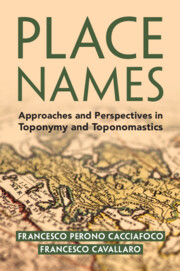Book contents
- Place Names
- Place Names
- Copyright page
- Contents
- Figures
- Tables
- Preface
- Acknowledgements
- 1 Introduction
- 2 Language Change
- 3 Historical Toponomastics
- 4 Toponymy and the Historical-Linguistic Reconstruction of Proto-Languages
- 5 Diachronic Toponymy
- 6 Landscape and Toponymy
- 7 Historical Toponomastics and Historical Geography
- 8 Synchronic Toponymy
- 9 Place Names and Society
- 10 Toponymy and Cartography
- Glossary
- References
- Index
6 - Landscape and Toponymy
Published online by Cambridge University Press: 02 March 2023
- Place Names
- Place Names
- Copyright page
- Contents
- Figures
- Tables
- Preface
- Acknowledgements
- 1 Introduction
- 2 Language Change
- 3 Historical Toponomastics
- 4 Toponymy and the Historical-Linguistic Reconstruction of Proto-Languages
- 5 Diachronic Toponymy
- 6 Landscape and Toponymy
- 7 Historical Toponomastics and Historical Geography
- 8 Synchronic Toponymy
- 9 Place Names and Society
- 10 Toponymy and Cartography
- Glossary
- References
- Index
Summary
The relationship between landscape and place names is very strong. In ancient times, places were named after natural resources and the landscape’s hydro-geo-morphological features. This trend persists today in some contexts. For instance, Abui place names on Alor Island are named after important landscape features, agricultural and horticultural crops, and useful plants. Abui toponyms are compounded with lexemes describing human settlements and highlighting the close relationship between nature and man. This chapters shows how the analysis of the landscape and related disciplines, like landscape archaeology (the study of the past use of the landscape determined by archaeological findings), enable scholars to reconstruct the remote origins of toponyms both in Indo-European and non-Indo-European contexts. While landscape is often considered in association with the physical features of a territory, the authors call for a holistic view of the landscape itself, which blends physical, social, cultural, environmental, and religious dimensions. To this end, toponyms are useful tools providing the researchers with insights into how people use or used the landscape.
- Type
- Chapter
- Information
- Place NamesApproaches and Perspectives in Toponymy and Toponomastics, pp. 134 - 157Publisher: Cambridge University PressPrint publication year: 2023



